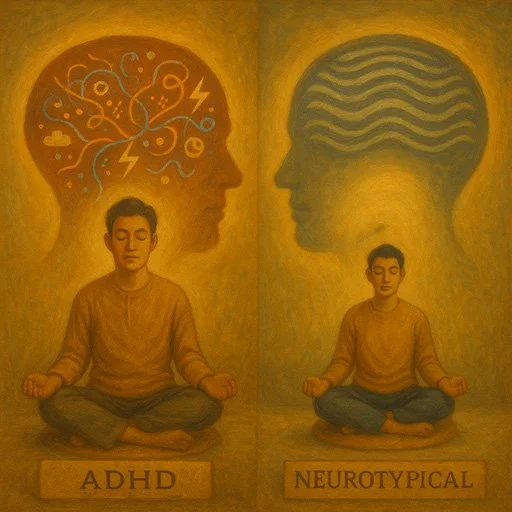Mindfulness for Adult ADHD: Evidence-Based Meditation Techniques
Author: Dr. Timothy Rubin, PhD in Psychology
Originally Published: August 2025
Last Updated: August 2025

Mindfulness meditation can be specifically adapted for ADHD brains to improve focus, attention, and emotional regulation.
Contents
- Understanding ADHD and Mindfulness
- The Clinical Evidence for Mindfulness in ADHD
- ADHD-Adapted Mindfulness Techniques
- ADHD Demographics: Late Diagnosis in Women
- Technology and AI-Powered Mindfulness Support
- Integrating Mindfulness into ADHD Treatment
- Getting Started with ADHD Mindfulness Practice
- FAQ: Mindfulness for Adult ADHD
Can mindfulness meditation actually help adults with ADHD focus better? The answer, according to emerging research, is a resounding yes. Multiple studies show mindfulness interventions can significantly improve ADHD symptoms, with effect sizes comparable to some medications.
However, traditional meditation approaches often fail for ADHD brains. Racing thoughts, physical restlessness, and executive functioning challenges make standard 45-minute sitting practices nearly impossible for many adults with ADHD.
The key lies in ADHD-adapted mindfulness techniques that work with, rather than against, the neurobiological realities of attention differences. These modified approaches can help the 15.5 million U.S. adults with ADHD develop better focus, emotional regulation, and overall quality of life.
Understanding ADHD and Mindfulness

ADHD brains process information differently, requiring adapted mindfulness approaches that honor these neurobiological differences.
Adult ADHD affects attention, hyperactivity, and impulse control in ways that can make traditional meditation feel impossible. The constant mental chatter, need for movement, and difficulty sitting still aren't character flaws—they're neurobiological differences that require adapted approaches.
Traditional mindfulness practices often emphasize sustained attention on a single object, like the breath. For ADHD brains, this can feel overwhelming and lead to frustration rather than calm.
ADHD-adapted mindfulness techniques acknowledge these challenges. Instead of fighting against restlessness, they incorporate movement. Rather than demanding perfect focus, they celebrate moments of awareness and gently redirect attention when it wanders.
Why Standard Meditation Struggles with ADHD
Research identifies several key barriers that make traditional meditation difficult for adults with ADHD:
- Executive functioning challenges that make it hard to organize and stick to practice routines
- Physical hyperactivity that makes sitting still for extended periods uncomfortable
- Attention regulation difficulties that cause rapid mind-wandering
- Emotional sensitivity that can make meditation feel overwhelming initially
Understanding these challenges is crucial for developing effective meditation practices that actually work for ADHD brains.
The Clinical Evidence for Mindfulness in ADHD
The research foundation for mindfulness meditation for ADHD has grown substantially over the past decade. A comprehensive 2019 meta-analysis found medium to large effect sizes for mindfulness interventions in reducing ADHD symptoms, particularly inattention and executive functioning problems.
Key findings from recent research include:
- Large improvements in executive functioning
- Significant emotional regulation benefits
- Enhanced quality of life measures
- Sustained benefits at follow-up for participants who continued practice
The UCLA Mindful Awareness Practices (MAPs) program demonstrated that 78% of participants reported symptom improvement. Importantly, these benefits were maintained or enhanced over time for those who continued mindfulness practice.
Comparable Effects to Medication
Perhaps most remarkably, some studies suggest mindfulness effects are comparable to stimulant medications for certain ADHD symptoms, particularly attention and emotional regulation. However, researchers emphasize that mindfulness works best as complementary treatment alongside established therapies.
This is particularly relevant given that 71% of adults on stimulants experience prescription difficulties due to shortages, making alternative approaches increasingly valuable.
ADHD-Adapted Mindfulness Techniques

Movement-based mindfulness practices work better for many adults with ADHD than traditional sitting meditation.
Effective ADHD mindfulness techniques require significant modifications from traditional approaches. Research has identified specific adaptations that dramatically improve success rates for adults with attention differences.
Shorter, Focused Sessions
The most effective ADHD meditation programs reduce formal practice time by up to 70% compared to standard approaches. UCLA's MAPs program progresses from 5-minute sessions to just 15 minutes maximum, far shorter than traditional 45-minute practices.
Starting recommendations for ADHD meditation:
- Week 1-2: 3-5 minute sessions
- Week 3-4: 5-8 minute sessions
- Week 5+: 10-15 minute sessions maximum
This graduated approach prevents overwhelm while building sustainable habits. Many adults with ADHD find that consistent short practices are more beneficial than sporadic longer sessions.
Movement-Based Mindfulness
For hyperactive presentations, movement-based meditation addresses the clinical reality that many adults with ADHD cannot sit still for extended periods. Research shows these adaptations maintain therapeutic benefits while working with ADHD neurobiology.
Effective movement practices include:
- Walking meditation with focus on foot sensations
- Mindful stretching that combines gentle movement with breath awareness
- Martial arts-based approaches that channel hyperactivity into structured movement
- Fidget-friendly meditation that allows small movements during practice
These approaches honor the ADHD need for movement while building mindfulness skills. Many practitioners find movement meditation easier to sustain than traditional sitting practices.
Multi-Sensory Approaches
ADHD brains often benefit from multiple anchor points for attention rather than single-focus techniques. Multi-sensory approaches provide scattered attention with various points of interest while building concentration skills.
Effective multi-sensory techniques:
- Tactile objects like stress balls or textured stones during meditation
- Environmental sounds as additional focal points alongside breath
- Visual anchors such as candles or nature scenes
- Guided imagery that engages multiple senses simultaneously
The "blue sky, white clouds" metaphor works particularly well—where awareness is the sky and thoughts are temporary clouds. This provides concrete imagery for abstract mindfulness concepts that can otherwise frustrate ADHD minds.
ADHD Demographics: Late Diagnosis in Women

61% of women with ADHD receive their diagnosis in adulthood, often after decades of unexplained struggles with attention and emotional regulation.
The statistics on adult ADHD diagnosis reveal a striking gender disparity with profound implications for treatment approaches. 61% of women receive their ADHD diagnosis in adulthood compared to 40% of men, with only 25% of women diagnosed before age 11 versus 45% of men.
This late recognition often follows decades of internalized shame, academic struggles, and misattributed mental health challenges. Many women discover their ADHD only when their children are diagnosed or when life demands exceed their compensatory strategies.
Why Women Seek Mindfulness Approaches
Women with undiagnosed ADHD experience higher rates of anxiety, depression, and mood disorders, making them particularly drawn to holistic approaches like mindfulness that address emotional regulation alongside attention challenges.
Research consistently shows mindfulness interventions produce large benefits for emotional regulation, addressing core areas where women with ADHD often struggle most.
The childhood diagnostic ratio of 3:1 male-to-female shifts toward 1:1 in adulthood, suggesting massive underdiagnosis of girls whose symptoms often present as inattentive rather than disruptive. These women frequently find mindfulness particularly helpful for managing the emotional overwhelm that accompanies late diagnosis.
Mindfulness for Late-Diagnosed Adults
For adults seeking non-medication approaches, mindfulness offers particular appeal given medication access challenges. With 71.5% of adults on stimulants experiencing prescription difficulties due to shortages, mindfulness-based interventions avoid these systemic barriers while providing evidence-based support.
Many late-diagnosed women report that mindfulness helps them develop self-compassion and acceptance around their ADHD diagnosis, complementing other cognitive behavioral therapy approaches they may be exploring.
Technology and AI-Powered Mindfulness Support
Digital therapeutics and AI-powered meditation show promising early results for ADHD populations, though research remains limited. A 2023 meta-analysis of digital interventions found significant improvements in attention and executive function, with particularly strong effects on inattentive symptoms.
Technology advantages for ADHD brains include:
- 24/7 availability when traditional support isn't accessible
- Personalized session lengths that adapt to current attention capacity
- Gamification elements that maintain engagement for ADHD minds
- Progress tracking that provides concrete feedback on improvements
AI-Personalized Meditation for ADHD
AI-powered platforms can provide personalized meditation experiences that allow users to more easily find and customize meditations for their particular needs. When you're experiencing particular challenges—like work stress or emotional overwhelm—AI can generate tailored practices that combine mindfulness awareness with gentle attention training.
These digital tools are particularly valuable for maintaining practice between therapy sessions or when access to ADHD-specialized mindfulness groups is limited. The key is finding platforms that maintain the authentic spirit of mindfulness while leveraging technology's strengths in personalization and accessibility.
For example, users can leverage AI-powered wellness platforms to easily generate personalized walking or movement meditations, request shorter durations, or incorporate multi-sensory elements that better suit their needs.
Integrating Mindfulness into ADHD Treatment
Current treatment landscape data reveals significant gaps in adult ADHD care that mindfulness interventions might help address. While 50.4% of adults with ADHD receive medication, 36.5% receive no treatment at all. Of those receiving treatment, only 35.2% get both medication and behavioral interventions despite clinical guidelines recommending multimodal approaches.
Mindfulness fits most naturally as adjunctive treatment addressing residual symptoms after medication optimization or supporting individuals who cannot tolerate medications. The approach shows particular promise for emotional regulation, self-compassion, and attention training—areas where traditional treatments sometimes fall short.
Professional Integration
Professional integration remains gradual but growing. Canadian researchers recommend incorporating mindfulness into clinical guidelines, while leading medical centers increasingly offer mindfulness programs for ADHD populations.
The safety profile remains favorable with minimal side effects, making it accessible even for individuals with complex medical presentations. Eight-week group programs emerge as the optimal format, balancing skill development time with attention span realities.
Many therapists now integrate mindfulness techniques with other evidence-based approaches like CBT and DBT, creating comprehensive treatment plans that address both attention challenges and emotional regulation needs.
Getting Started with ADHD Mindfulness Practice
Starting a mindfulness practice with ADHD requires a different approach than traditional meditation programs. The key is to begin small, stay flexible, and celebrate progress over perfection.
Week 1-2: Foundation Building
- Start with 3-5 minute sessions using guided meditations
- Choose consistent timing (like after morning coffee)
- Allow movement if sitting still feels impossible
- Use external anchors like soft music or nature sounds
Week 3-4: Expanding Awareness
- Gradually increase to 5-8 minutes if comfortable
- Experiment with different techniques (walking, body scan, breathing)
- Notice what works best for your specific ADHD presentation
- Track your mood and focus before and after sessions
Week 5+: Building Sustainability
- Aim for 10-15 minute maximum sessions (longer isn't necessarily better)
- Develop multiple practice options for different energy levels
- Connect with supportive communities online or in-person
- Integrate brief mindful moments throughout your day
Important Reminders for ADHD Practitioners
Remember that consistency matters more than perfection. Missing days is normal—simply restart without self-judgment. Many adults with ADHD find that shorter, more frequent sessions work better than trying to maintain longer daily practices.
Consider combining mindfulness with other daily habits that reduce anxiety and support overall mental wellness. The goal isn't to eliminate ADHD symptoms but to develop a healthier, more compassionate relationship with your unique brain.
-Tim, Founder of Wellness AI
About the Author
Dr. Timothy Rubin holds a PhD in Psychology with expertise in cognitive science and AI applications in mental health. His research has been published in peer-reviewed psychology and artificial intelligence journals. Dr. Rubin founded Wellness AI to make evidence-based mental health support more accessible through technology.
FAQ: Mindfulness for Adult ADHD
Can mindfulness meditation really help with ADHD symptoms?
Yes, research shows mindfulness interventions can significantly improve ADHD symptoms with medium to large effect sizes, particularly for attention and emotional regulation. However, traditional approaches need modification for ADHD brains to be effective.
Why is traditional meditation so difficult for people with ADHD?
ADHD brains struggle with traditional meditation due to racing thoughts, physical restlessness, and executive functioning challenges that make long sitting practices nearly impossible. Standard meditation often fights against ADHD neurobiology rather than working with it.
How long should ADHD meditation sessions be?
Start with 5-minute sessions and gradually work up to 15 minutes maximum. Research shows shorter sessions are more effective for ADHD brains than traditional 45-minute practices. Consistency matters more than duration.
Are women with ADHD diagnosed differently than men?
Yes, 61% of women receive their ADHD diagnosis in adulthood compared to 40% of men, often because symptoms present as inattentive rather than disruptive in childhood. Many women find mindfulness particularly helpful for emotional regulation challenges.
What are the best mindfulness techniques for ADHD?
Movement-based practices like walking meditation, shorter sessions (5-15 minutes), multi-sensory approaches with tactile objects, and guided meditations work best. The key is adapting techniques to work with ADHD neurobiology rather than against it.
Can mindfulness replace ADHD medication?
Mindfulness should complement, not replace, established treatments. It works best alongside medication and other evidence-based therapies as part of comprehensive ADHD care. Always consult healthcare providers about treatment changes.